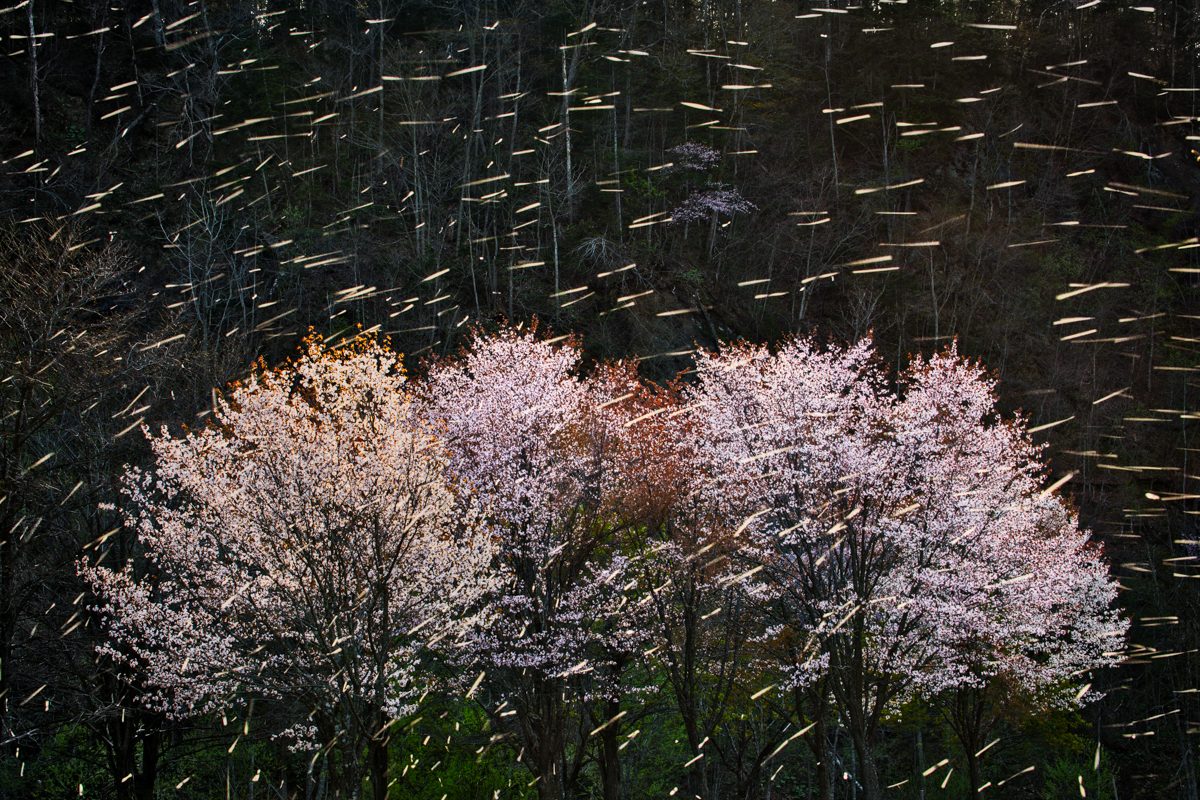


Xuan-Hui Ng’s mother had a green thumb. “She grew orchids and watered them with water from the fish pond,” the artist remembers. “She loved chrysanthemums most of all.” Ng’s mother, who supported her unconditionally throughout her life, passed away in 2000. She never got to see her daughter become a photographer, but her memory can be found in all of the pictures she’s made—particularly the cherry blossom photography.
Cherry blossoms are only in bloom for one to two weeks each year, sometimes less. They arrive, and then they peak and disappear. Since 2016, Ng has followed the flowers across Hokkaido, Nagano, and Aomori. Hokkaido, where the artist spent some of her childhood winters, is home to seasonal wonders like lavender fields, hot springs, forests, and snow-capped mountains.
Ng moved to Japan to be closer to Hokkaido, and she visits throughout the year. “The distinct seasons and significant temperature swings between night and day give rise to breathtaking natural phenomena like mist, frost, and diamond dust,” the photographer tells me.
In Aomori, she’s seen early springtime erupt at Hirosaki Castle in the form of more than 2,500 cherry trees in full bloom. “The castle features around 50 types of cherry blossom trees, including the more well-known Somei Yoshino, Shidare-zakura, and Yae-zakura,” Ng explains. “Every Spring, the cherry blossom petals fall into the moat, forming a carpet of pink petals on the water’s surface.”
The cherry blossoms come and go in weeks, if not days. For this kind of cherry blossom photography, the timing must be perfect, especially if Ng wants to capture the flowers “in flight”—that is, falling and blowing in the wind. She watches the forecasts issued by the Japan Metrological Corporation and plans her trips accordingly, but it’s never a guarantee she’ll be there at the right moment.
Due to the brief window of opportunity, she works with whatever weather conditions the day might bring, whether it’s warm and sunlit or dark and rainy. “Luck plays a critical part,” Ng admits. “Nature and luck are my ‘partners in crime.’ My images are a collaboration with nature. They serve to eternalize those ephemeral moments.”
Despite the fleeting nature of these moments—and the knowledge that none can ever be repeated—time seems to move differently when Ng watches the flowers fall: “When I’m photographing, it’s as if I am bewitched. I think of nothing but the nature that surrounds me.” She’s embraced happy accidents and serendipity. Chasing cherry blossoms has inspired her to be more playful; cherish every instant; and see the world through new eyes, as a young child might.
In many ways, the pictures themselves also exist outside of time; depending on the exposure, the water—and the pink petals themselves—might be frozen in space, hovering preternaturally. Or, through the use of longer exposures, the flowers could blur like stars across the night sky.
In Ng’s work, there’s no sense of “up” or “down,” either. Through reflections, she invites us to walk on clouds. Sheets of fog make it hard to determine whether objects are very far away—or close enough to touch. In some cases, an impossibly shallow depth of field makes nearby objects seem just out of reach, like moments from a dream lost upon waking.
Ng’s pictures are like memory itself in that time and space don’t move linearly; they compress and expand. The past is present, and those who are gone become present once more. While making them, the artist felt the spirit of her mother beside her.
When Ng’s mother died, she “buried” herself in work (at the time, she was an investment banker). “I ran from grief,” she says now. “I tried not to think too much of my mother because it hurt too much. However, as grief ebbs, memories do too. I was losing what I had remaining of her. Choosing to photograph cherry blossoms in memory of her was my way to re-embrace my love for her, without the acute pain of loss.”
Her collection of cherry blossom photography, dedicated to her mother, is titled Remembrance. “I believe that sadness, like all emotions, can become habitual,” Ng adds. “When one is sad for a protracted period of time, it’s easy to forget what it was like to be happy. Photographing nature was the new habit that broke the spell of sadness for me.”
Hokkaido was the setting for some of Ng’s most indelible childhood memories: when she was young, she’d go skiing there with her family. She aches when she sees mothers and daughters together. But by the time the cherry blossoms arrive in spring, that pain gives way to wonder.
“The flowers remind me not of what I have lost but what my mother would have loved,” the artist tells me. “I think she would have appreciated the beauty of the cherry blossoms—and the brevity of their lives.”







All images © Xuan-Hui Ng
If you’re interested in cherry blossom photography from Japan, read our article on the work of Hiroaki Hasumi next.
Discover More
Source link



Leave a Reply